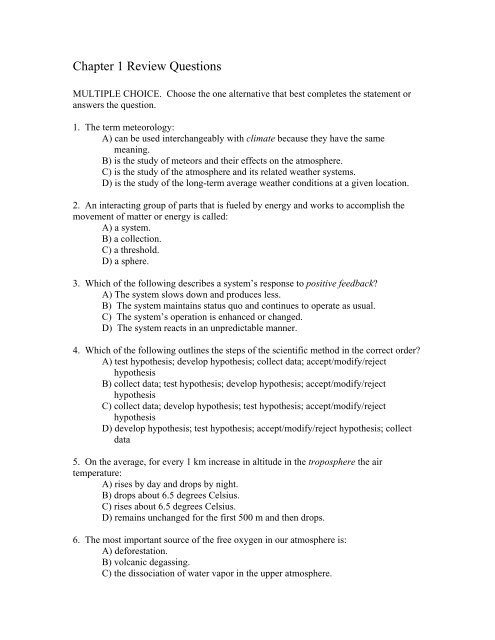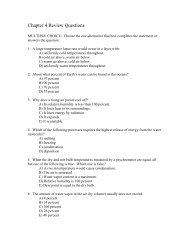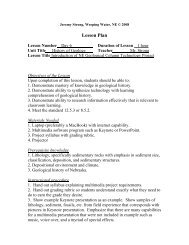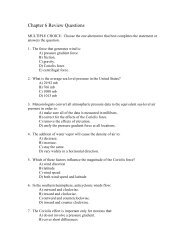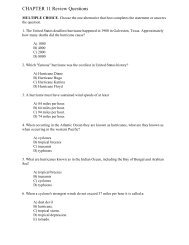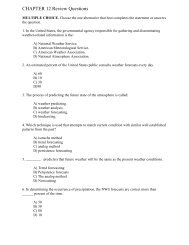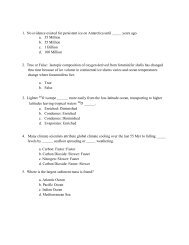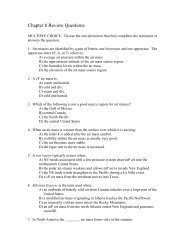CHAPTER 1 Review Questions.pdf
CHAPTER 1 Review Questions.pdf
CHAPTER 1 Review Questions.pdf
You also want an ePaper? Increase the reach of your titles
YUMPU automatically turns print PDFs into web optimized ePapers that Google loves.
Chapter 1 <strong>Review</strong> <strong>Questions</strong><br />
MULTIPLE CHOICE. Choose the one alternative that best completes the statement or<br />
answers the question.<br />
1. The term meteorology:<br />
A) can be used interchangeably with climate because they have the same<br />
meaning.<br />
B) is the study of meteors and their effects on the atmosphere.<br />
C) is the study of the atmosphere and its related weather systems.<br />
D) is the study of the long-term average weather conditions at a given location.<br />
2. An interacting group of parts that is fueled by energy and works to accomplish the<br />
movement of matter or energy is called:<br />
A) a system.<br />
B) a collection.<br />
C) a threshold.<br />
D) a sphere.<br />
3. Which of the following describes a system’s response to positive feedback<br />
A) The system slows down and produces less.<br />
B) The system maintains status quo and continues to operate as usual.<br />
C) The system’s operation is enhanced or changed.<br />
D) The system reacts in an unpredictable manner.<br />
4. Which of the following outlines the steps of the scientific method in the correct order<br />
A) test hypothesis; develop hypothesis; collect data; accept/modify/reject<br />
hypothesis<br />
B) collect data; test hypothesis; develop hypothesis; accept/modify/reject<br />
hypothesis<br />
C) collect data; develop hypothesis; test hypothesis; accept/modify/reject<br />
hypothesis<br />
D) develop hypothesis; test hypothesis; accept/modify/reject hypothesis; collect<br />
data<br />
5. On the average, for every 1 km increase in altitude in the troposphere the air<br />
temperature:<br />
A) rises by day and drops by night.<br />
B) drops about 6.5 degrees Celsius.<br />
C) rises about 6.5 degrees Celsius.<br />
D) remains unchanged for the first 500 m and then drops.<br />
6. The most important source of the free oxygen in our atmosphere is:<br />
A) deforestation.<br />
B) volcanic degassing.<br />
C) the dissociation of water vapor in the upper atmosphere.
D) green plants that carry on photosynthesis.<br />
7. Which of the following is NOT true of radiosondes<br />
A) They are launched hourly from nearly every weather station in the United<br />
States.<br />
B) They send meteorological data to the ground via radio transmitters.<br />
C) They are critical sources of data for weather forecasters.<br />
D) They are carried aloft by weather balloons.<br />
8. This atmospheric component absorbs damaging ultraviolet radiation from the Sun.<br />
A) nitrogen<br />
B) helium<br />
C) neon<br />
D) argon<br />
E) ozone<br />
9. The four thermal layers of the atmosphere in order beginning from the surface are:<br />
A) troposphere, stratosphere, mesosphere, thermosphere<br />
B) mesosphere, stratosphere, thermosphere, troposphere<br />
C) thermosphere, stratosphere, mesosphere, troposphere<br />
D) stratosphere, troposphere, mesosphere, thermosphere<br />
10. Which of these is NOT a significant factor in the role played by particles or dust in<br />
the atmosphere<br />
A) absorption of sunlight<br />
B) ozone production<br />
C) reflection of sunlight<br />
D) cloud formation<br />
11. The normal lapse rate applies to the:<br />
A) stratosphere<br />
B) troposphere<br />
C) thermosphere<br />
D) mesosphere<br />
12. The majority of the water outside of the oceans is in the form of:<br />
A) streams<br />
B) groundwater<br />
C) lakes<br />
D) glacial ice<br />
E) water vapor in the atmosphere<br />
13. Which one of the following gases has the greatest effect on weather<br />
A) oxygen<br />
B) water vapor<br />
C) ozone
D) argon<br />
E) nitrogen<br />
14. The Montreal Protocol:<br />
A) called for a 10 percent reduction in CFC production by the end of the century.<br />
B) has already created a reduction in ozone-depleting gases in the atmosphere.<br />
C) is generally considered a diplomatic disaster by most environmentalists.<br />
D) was not adhered to by the United States.<br />
E) was designed primarily to address the problem of global warming.<br />
TRUE/FALSE. Write ‘T’ if the statement is true and ‘F’ if the statement is false.<br />
15. Weather occurs in the thermosphere.<br />
16. Ozone is continually created in our atmosphere by solar radiation.<br />
17. Ozone is a significant atmospheric component in the greenhouse effect.<br />
18. Weather and climate are synonymous terms.<br />
19. Although carbon dioxide is present only in small amounts, it is still more significant<br />
meteorologically than the other more abundant gases composing dry air.<br />
20. Scientific hypotheses are rejected when they do not agree with observed data.<br />
21. The atmosphere ends abruptly at an altitude of 30 kilometers.<br />
22. A scientific hypothesis may be regarded as a tentative explanation of observed facts<br />
or events.<br />
23. There is a sharp and definable boundary between the atmosphere and outer space.<br />
24. The environmental lapse rate is not constant.<br />
25. Satellites do not orbit in the thermosphere because the intense heat would quickly<br />
incinerate them.


